Postcards: A 10-Year Celebration of Community
By Mike Yawn
Photos by Kelly Lawson
Mass media specialists and social scientists have painted a depressing trend over the past 25 years: communities are growing more fragmented and, not coincidentally, print journalism is suffering. Social media, on the other hand, is all the rage—in all meanings of the word. It was a bit of a surprise then that Wes and Karen Altom decided some 10 years ago to launch a community magazine. Against prevailing trends, and no doubt counter to economists’ prognostications, the magazine has thrived, filling a niche in Walker County and, beginning the following year, in Montgomery County. What follows is the story of that success and, more broadly, the success of two community areas in southeast Texas.
In 2009-2010, the country was in the midst of “The Great Recession.” Print journalism was in a freefall. What made you wake up and say, “Gosh, this would be a great time to start a print magazine?!”
Karen Altom: It was really many things coming together serendipitously. I had worked with Mary Partida for several years with an advertising business, and we were realizing it was becoming more and more difficult to market events. Communities were turning away from a single source of information and, consequently, it was becoming increasingly difficult to reach an entire community. At the same time, stories would pop into my head, and I would think, “That would make for a great magazine article.” But I would back off and say, “I don’t have time to take on another project.” But in 2010, one of our clients sold their company, and we took a hit in ad revenue. It also opened up a time window. And I said, “Okay, Lord, I don’t have an excuse anymore. Maybe it is time start a magazine.”
How did you put that plan into action?
KA: We had a planning session with Mary at IHOP, and Wes asked some of the hard questions. “What are our resources? What is the content?” Those were questions we had to answer, but we had experience in media, the ability to write, some of the infrastructure, and we had Mary as a graphic designer and Julie Knight as a photographer.
Wes Altom: We thought there was a need. We believed there is still a demand for community journalism, and we could provide the material—the photos and the stories—that no one else, certainly no one else at the national level, was providing about this area. Huntsville is large enough to have a customer base and some advertisers, but small enough to still have a sense of community and an identification as such.
How did you plan out the division of labor?
KA: Wes is more of “Just the facts, ma’am.” (Wes nods at this point.) I try to ensure there is “heart” in each issue. So, in a way, I am the touchy-feely aspect of the magazine, and he is the facts and history aspects of the magazine. But on an operational level, I have served as the publisher, and he has served as the editor.
WA: I am the comma police.
KA: And I deal more with sales, but we both do the office duties. Wes does give me the veto power. Sometimes we get some content in articles that I don’t think my mother would appreciate, and I get to veto that…
I think you’ve vetoed some of my things…
KA: Deservedly so…
WA: …Don’t feel bad, she has vetoed some of my content, too.
KA: Also deservedly so…
WA: We may put together a “Postcards Uncensored.”
Can I be the photographer for that issue?
WA: But, seriously, we agreed at the outset our focus was on the community, that we would avoid politics, and we would emphasize positive stories. Our hope is when people read the magazine, they say, “I didn’t know that! I’ve lived in Huntsville for 15 years, and I didn’t know that.”
This Altom partnership began more than 28 years ago. Although Karen went to school at Abilene Christian University and Wes attended SHSU, the two became friends through a church group in Huntsville, soon began dating, and were married on October 17, 1992. This particular date came about after Wes suggested October 31, and his idea—not for the last time—was vetoed. Since then, Karen has enjoyed careers in radio, newspapers, and advertising. Wes was a police officer for more than two decades, before going into consulting. They have also raised two children—Abby and Marshall—and have recently taken up yet another career: babysitters for their grandchild, Walker.
Nothing works out exactly as planned. How has the job evolved over the years?
KA: Well, Wes took over supervision of the story assignments a couple of years ago, and we both write less than we first did. We want as many people as possible in the community to contribute as writers. We have talented people in our community, and we want to display both the community and its talented writers. The other two big aspects of the magazine’s evolution include the addition of the Lake Conroe edition, which we began in 2012, and the increased frequency of publication. We began quarterly, moved to six times a year, and within a few years, we were doing monthly issues. We now print 25,000 copies of each edition every month. Our printer deadline is the same day for both issues, so it makes for a long day. But our goal, as Wes said, is to get positive stories out there each month, and to provide content people want to read, and we’ve done that.
You’ve hinted at this, but how do your different personalities affect the magazine?
KA: Several years ago, we took a marriage class at church led by Dr. Foy Mills. We took the Gallup Strength Finders Assessment, and my number one strength was “positivity.” I want to paint my sky blue, my lawn green, and my picket fence white. Wes is about analyzing situations and processes, figuring out how things fit together. At first, I was alarmed because our personalities don’t have a lot in common, but we learned that it’s more about complementing one another, and we do that in life and on the magazine.
I ask Wes if he’d like to add to this, to which he responded: “No.” This reminds me of the time a woman sat next to President Calvin Coolidge at a dinner party. Even as President, Coolidge was notably taciturn, prompting the woman to say, “My friend bet me that I couldn’t get you to say more than two words all evening.” He replied: “You lose.”
What has proved most popular in the magazine?
KA: The most popular in terms of submissions are our sections on “pets” and “grandchildren.” When the issues hit the street, our emails light up with new submissions from readers.
What has been least expected?
KA: We didn’t realize the concept would take off. When we began—with just one edition—we had 175 rack locations, and we also mailed them out. We wanted the magazine to be everywhere. But we were surprised by the response. When we’d walk into our rack locations, people would say, “Are you bringing more?”
WA: Also, Karen is now occasionally recognized as “The Postcards Lady.”
KA: I was with Marshall one day at the grocery store, and a lady walked up to me, threw her arms around me (this was Pre-COVID), and hugged my neck. “I love your magazine,” she said. When she left, Marshall asked me, “Who was that?” And I didn’t know. It was just someone who knew me from the magazine!
It’s probably good this doesn’t happen to Wes.
WA: Now that people know her, Karen has to behave in public.
I like to think of milestones. Since the magazine began, we have had, as of this month, three presidents, an economic recession, a long economic expansion, now a pandemic economy—and, of course, COVID and all its effects. But on a personal level, what are some milestones since you began the magazine?
WA: It’s been a family business. Marshall and Abby have been involved in multiple ways, and I think they’ve become more well-rounded as community citizens as a result.
KA: Both our kids graduated from school since the magazine began. Abby did a study abroad program in college, and we traveled to see her, so we did a story on Germany. We had a foreign exchange student from Denmark, so we did a story on that. Both our children are now married, and Marshall and his wife Kathryn have a child.
You’ve had some more somber changes, as well.
KA: We’ve lost three out of four parents, and that has been tough. One of our team members, Chris Blair, died in a motorcycle accident. That was completely unexpected and horrible for us and his family. These losses can be quite emotional, and they can also have practical implications. My father was a minister, but he was also a mail carrier, and he would do all the rack deliveries in Madisonville. He loved doing that to help us, but I think he also enjoyed running into people. He would call us and say, “I ran into so-and-so, and they loved the story on such-and-such.” I have kept some of his voicemails. The magazine is a part of our life in ways far beyond the profits and losses, and we’re a better and stronger family because of it.
And do you think the community is stronger for it?
KA: We hope so. That’s been our goal for the past 10 years, and it’s our goal for the next 10 years.
I ask Wes if he’d like to add anything. He says, “No.” Karen informs me that he has used up all his words today, and will begin speaking again sometime tomorrow. I say goodbye to the two of them: Karen gives me an air hug, and Wes nods.
Side Bar 1: What goes into 10 years of Postcards:
Sidebar 2:
As noted in the interview, Postcards is a family enterprise, and the Altom children have been part of the magazine’s operations—sometimes willingly. Originally, both Marshall and Abby thought it might be a multi-year project that could lift the community. After seeing the work that went into it, they realized it was a long-term commitment on the part of their parents. “They started this magazine,” reflected Marshall, “because they love our community, and they wanted the community to unite around something positive.” Abby echoed and amplified those thoughts: “The magazine began at a tough time for our family, and I think we needed the magazine as much as the community did. I could not be more proud of my parents and their continued dedication to the magazine, the community, and to God.” Both, too, have been influenced personally by the magazine. “I was born and raised in Huntsville,” noted Marshall, “but through the magazine, I’ve learned of amazing people in the community. There is always more to a community than you know.” For Abby, the impact has also been personal, at times almost traumatically so. There was the time, as a college freshman, that she got to interview Aaron Watson for the magazine, only to find her only recording became corrupted—the file was irretrievably lost—prompting an awkward callback. But even while living in the Abilene area, she is amazed by what she learns from the magazine: “…a person in the community doing amazing things, or a new recipe, or keeping up with my mom through her publisher column. It makes me feel closer to my family. Oh yeah, one more thing I’ve learned: have a backup recording device for interviews.”
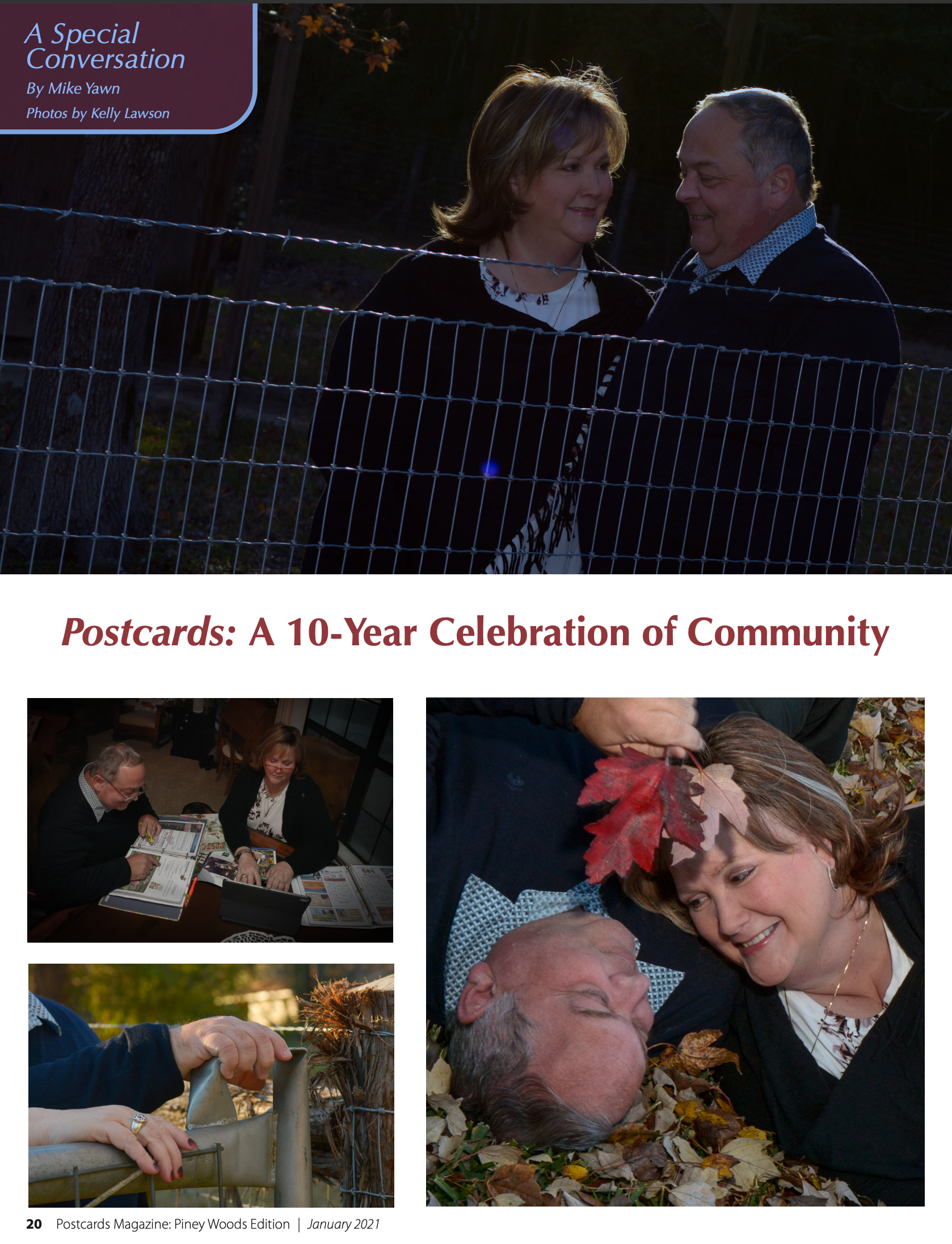

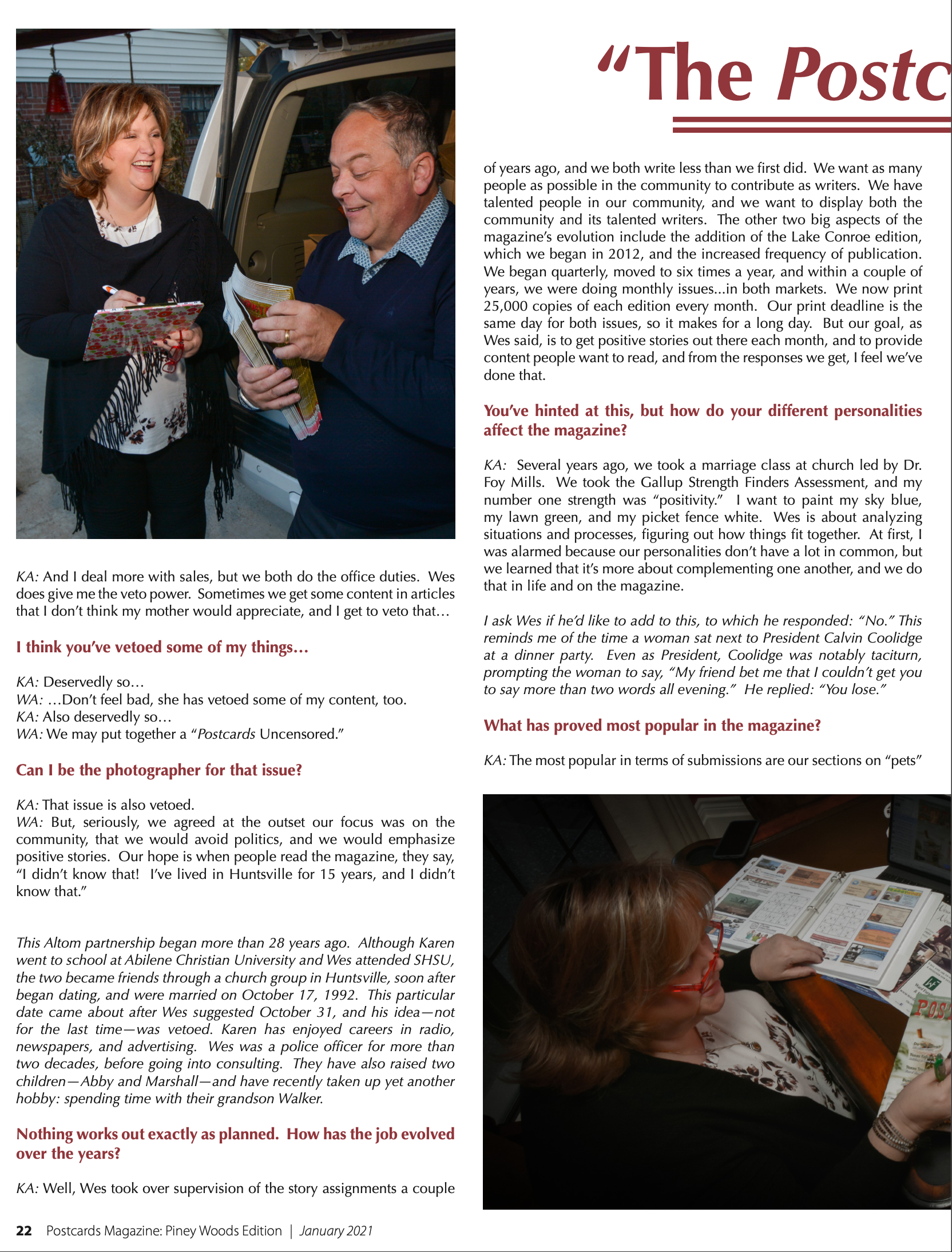
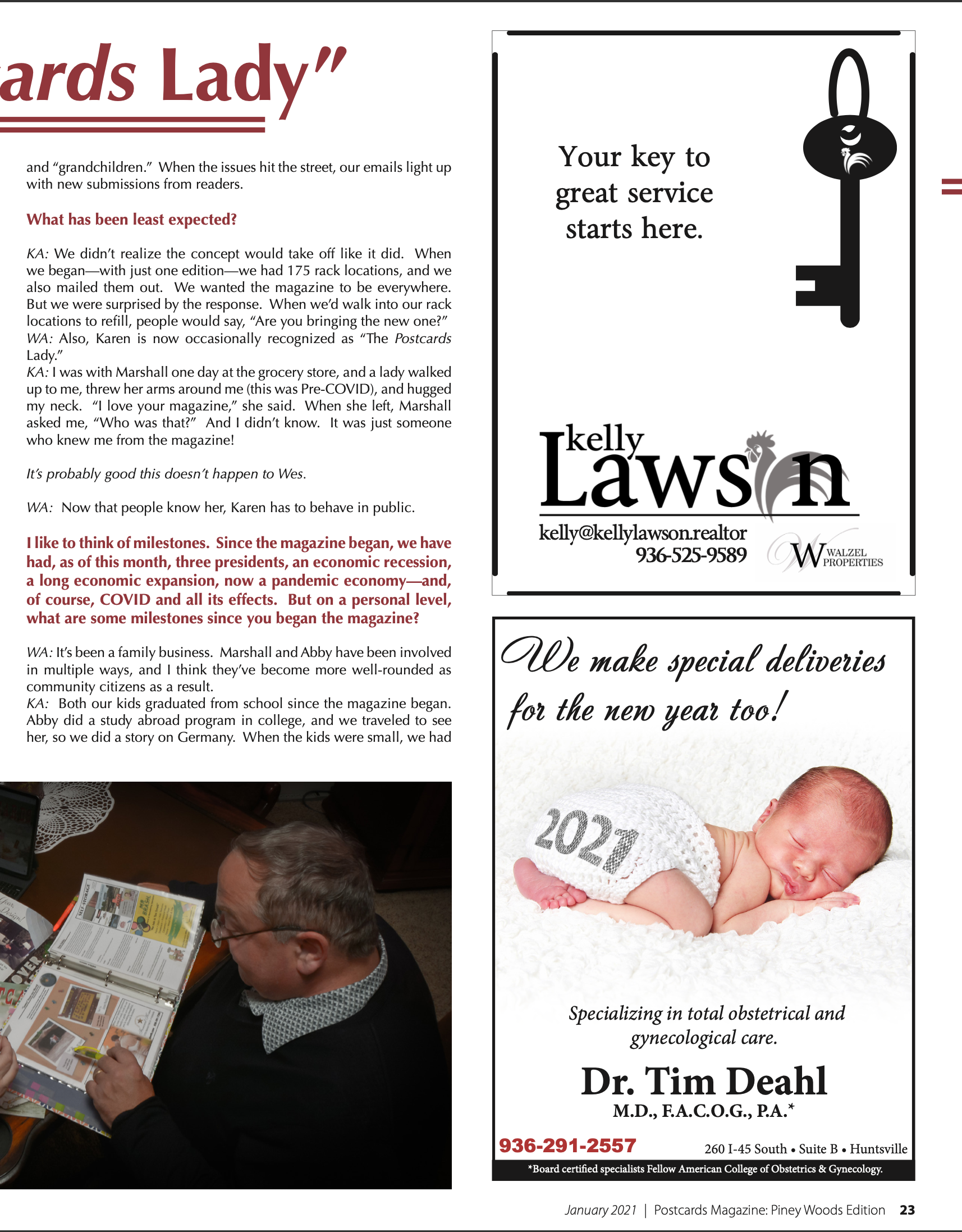
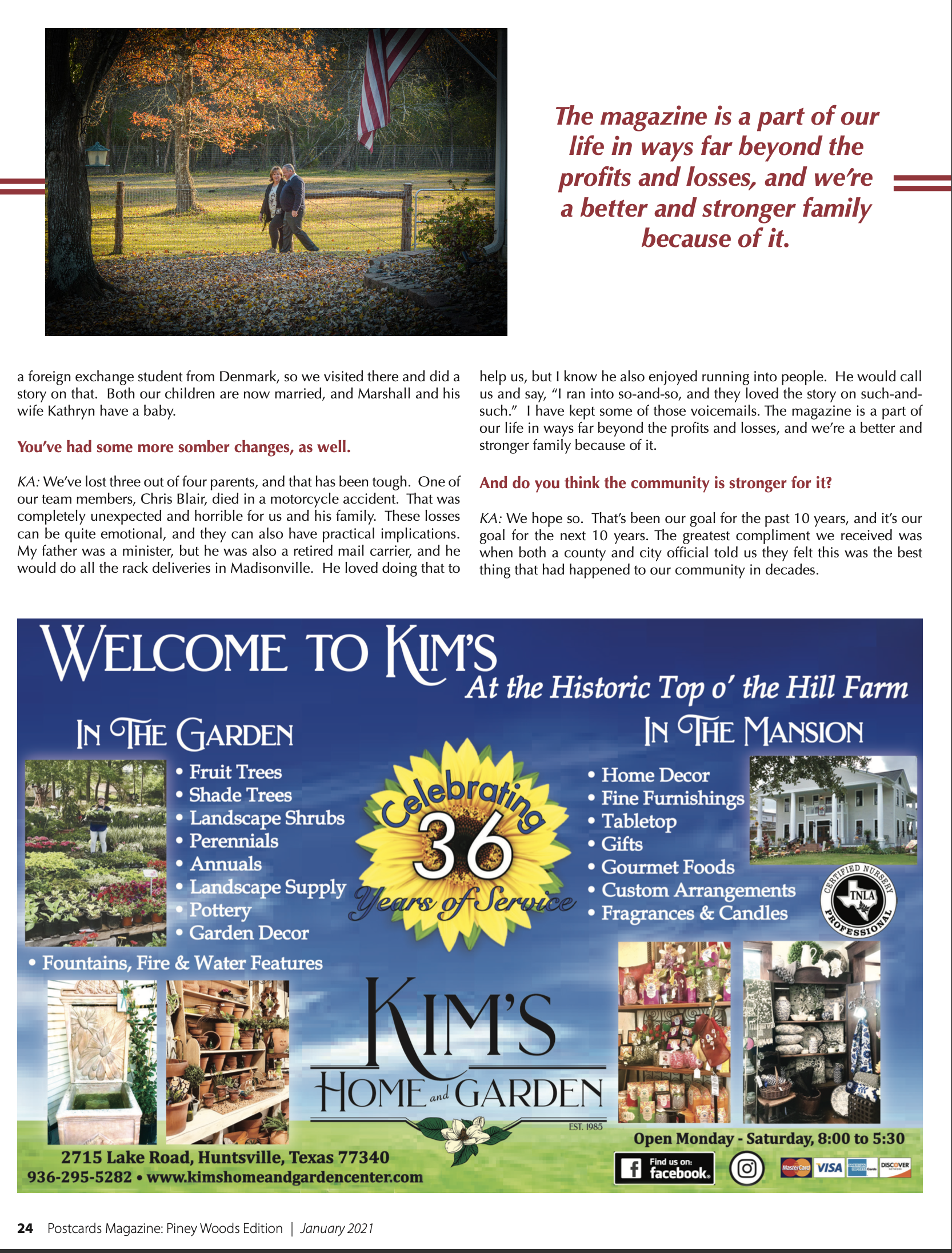
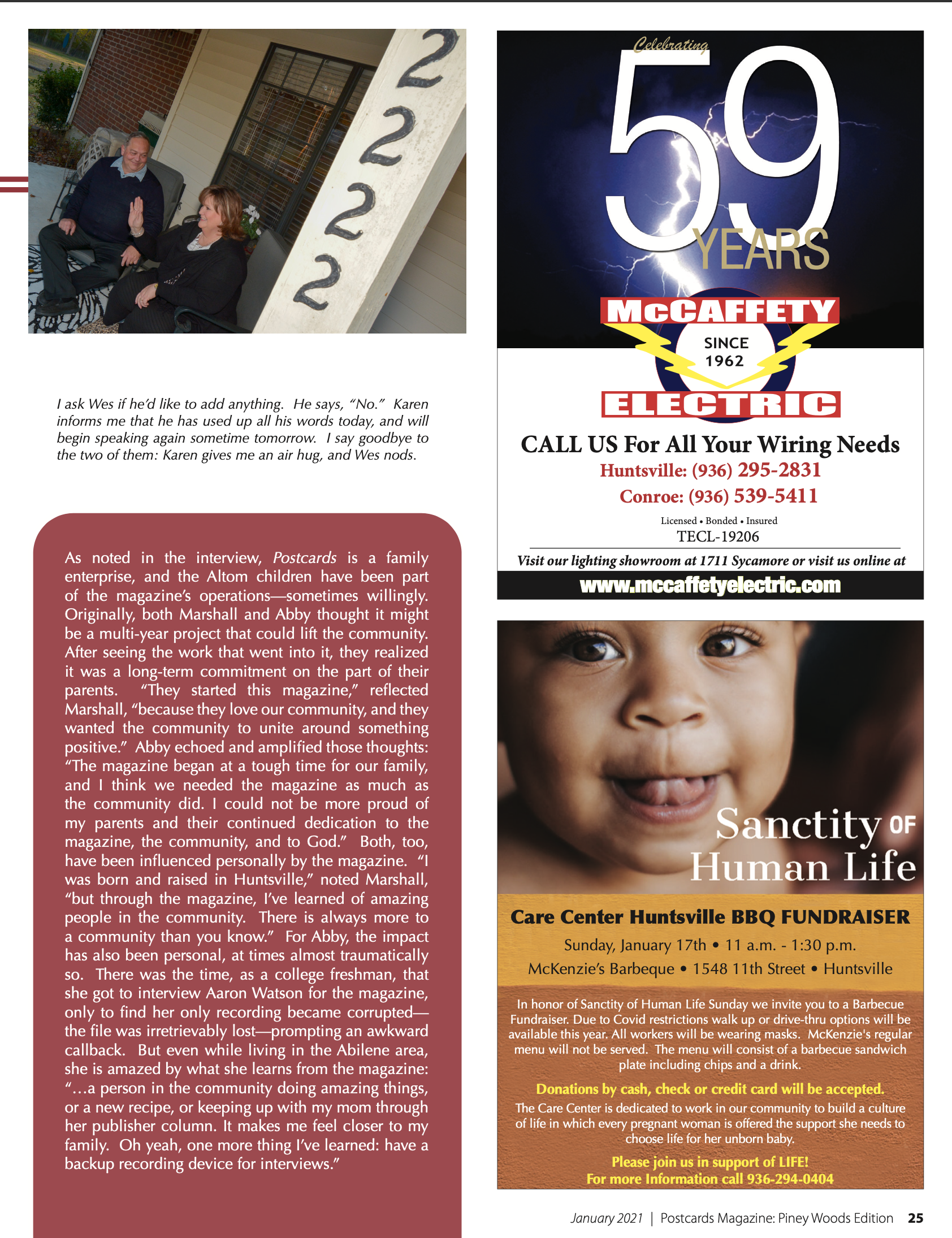

Postcards Magazine
936-293-1188
PO Box 690
Huntsville, TX 77342
